check engine Lancia Delta 2011 Owner handbook (in English)
[x] Cancel search | Manufacturer: LANCIA, Model Year: 2011, Model line: Delta, Model: Lancia Delta 2011Pages: 290, PDF Size: 8.36 MB
Page 182 of 290

3
STARTING AND DRIVING181
Keep your speed down when snow chains are
fitted. Do not exceed 50 km/h. Avoid pot-
holes, steps and pavements and also avoid
driving long distances on roads not covered with
snow in order to prevent damaging the car and the
roadbed.
SNOW CHAINS
The use of snow chains should be in compliance with lo-
cal regulations.
The snow chains may be applied only onto the front
wheel tyres (drive wheels).
Check the tension of the snow chains after the first few
metres have been driven.
IMPORTANT Snow chains cannot be fitted to the space-
saver spare wheel. So, if a front (drive) wheel is punc-
tured and chains are needed, a rear wheel should be fit-
ted to the front of the car and the space-saving spare
wheel should be fitted to the rear. This way with two nor-
mal drive wheels, snow chains can be fitted to them to
solve an emergency.
CAR INACTIVITY
If the car is to be left inactive for longer than a month,
the following precautions should be followed:
❍park the car in a covered, dry and, if possible, well-
ventilated place;
❍engage a gear;
❍check that the handbrake is not engaged;
❍disconnect the negative battery terminal (for versions
with Start&Stop system refer to the paragraph
“Start&Stop system” in chapter “1”);
❍clean and protect the painted parts of the vehicle with
protective wax;
❍clean and protect the shiny metal parts using special
compounds commercially available;
❍sprinkle talcum powder on the rubber windscreen and
rear window wiper blades and lift them off the glass;
❍open the windows slightly;
❍cover the car with a fabric or perforated plastic sheet.
Do not use sheets of non-perforated plastic as they
do not allow moisture on the car body to evaporate;
❍inflate tyres to a pressure of +0.5 bar above the nor-
mal specified pressure and check regularly;
❍do not drain the engine cooling system.
Page 190 of 290
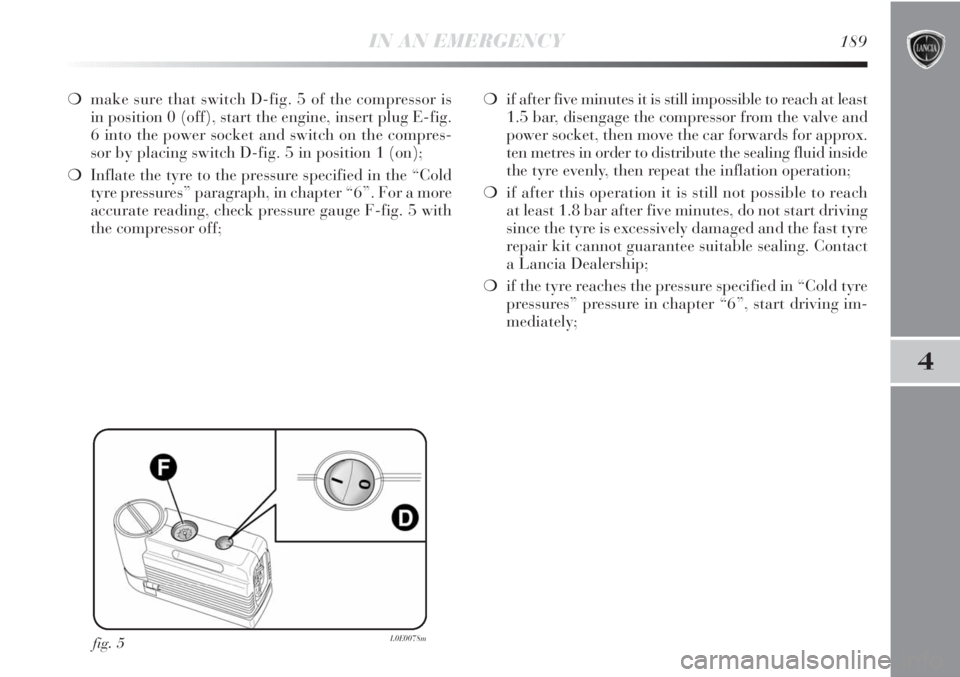
IN AN EMERGENCY189
4
❍make sure that switch D-fig. 5 of the compressor is
in position 0 (off), start the engine, insert plug E-fig.
6 into the power socket and switch on the compres-
sor by placing switch D-fig. 5 in position 1 (on);
❍Inflate the tyre to the pressure specified in the “Cold
tyre pressures” paragraph, in chapter “6”. For a more
accurate reading, check pressure gauge F-fig. 5 with
the compressor off; ❍if after five minutes it is still impossible to reach at least
1.5 bar, disengage the compressor from the valve and
power socket, then move the car forwards for approx.
ten metres in order to distribute the sealing fluid inside
the tyre evenly, then repeat the inflation operation;
❍if after this operation it is still not possible to reach
at least 1.8 bar after five minutes, do not start driving
since the tyre is excessively damaged and the fast tyre
repair kit cannot guarantee suitable sealing. Contact
a Lancia Dealership;
❍if the tyre reaches the pressure specified in “Cold tyre
pressures” pressure in chapter “6”, start driving im-
mediately;
fig. 5L0E0078m
Page 191 of 290

190IN AN EMERGENCY
❍after driving for about 10 minutes stop and check the
tyre pressure again; pull up the handbrake;❍if you get a pressure reading of at least 1.8 bar, restore
the correct pressure (with engine running and hand-
brake on) and continue your journey;
❍drive with the utmost care to the nearest Lancia Deal-
ership.
Apply the adhesive label in a position
clearly visible by the driver as a reminder
that the tyre has been treated with the quick
repair kit. Drive carefully, particularly on bends.
Do not exceed 80 km/h. Do not accelerate and
brake suddenly.
If the pressure falls below 1.8 bar, do not
drive any further: the quick tyre repair kit
Fix & Go automatic cannot guarantee suffi-
cient hold because the tyre is too damaged. Go to
a Lancia Dealership.
You must inform the dealership that the tyre
has been repaired using the quick tyre repair
kit. Hand the instruction brochure over to the
personnel charged with treating the tyre repaired
with the kit.
Page 214 of 290
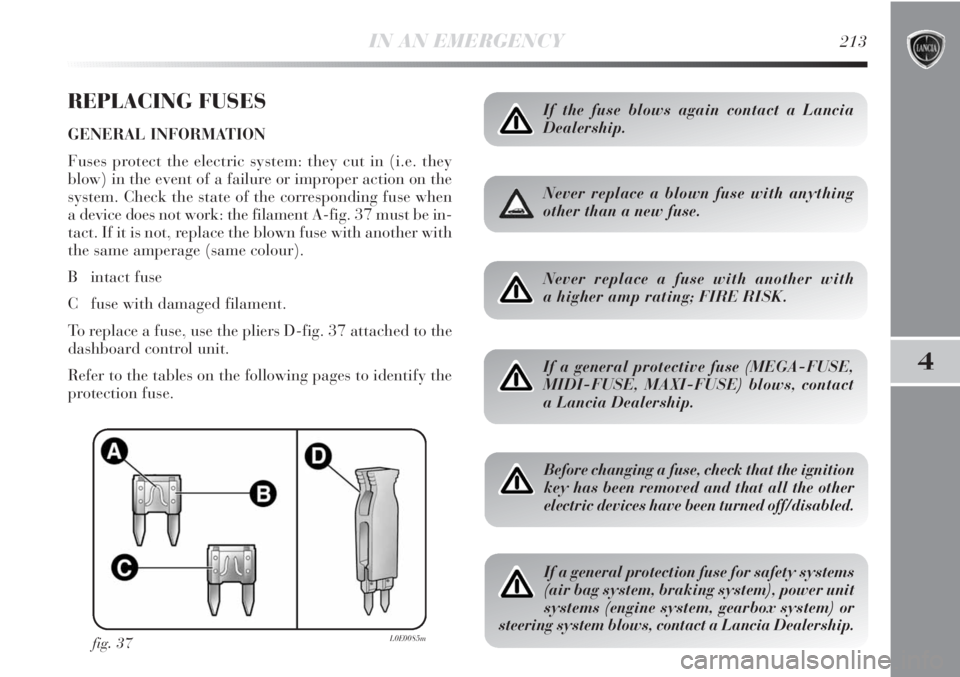
IN AN EMERGENCY213
4
REPLACING FUSES
GENERAL INFORMATION
Fuses protect the electric system: they cut in (i.e. they
blow) in the event of a failure or improper action on the
system. Check the state of the corresponding fuse when
a device does not work: the filament A-fig. 37 must be in-
tact. If it is not, replace the blown fuse with another with
the same amperage (same colour).
B intact fuse
C fuse with damaged filament.
To replace a fuse, use the pliers D-fig. 37 attached to the
dashboard control unit.
Refer to the tables on the following pages to identify the
protection fuse.
fig. 37L0E0085m
If the fuse blows again contact a Lancia
Dealership.
Never replace a blown fuse with anything
other than a new fuse.
Never replace a fuse with another with
a higher amp rating; FIRE RISK.
If a general protective fuse (MEGA-FUSE,
MIDI-FUSE, MAXI-FUSE) blows, contact
a Lancia Dealership.
Before changing a fuse, check that the ignition
key has been removed and that all the other
electric devices have been turned off/disabled.
If a general protection fuse for safety systems
(air bag system, braking system), power unit
systems (engine system, gearbox system) or
steering system blows, contact a Lancia Dealership.
Page 226 of 290
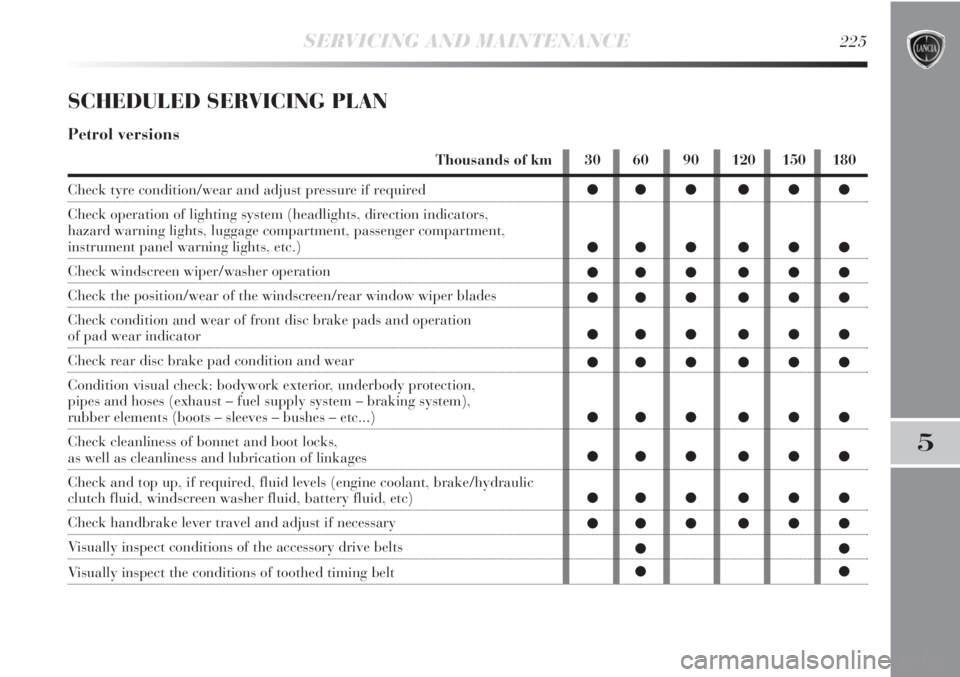
30 60 90 120 150 180
●●● ●●●
●●● ●●●
●●● ●●●
●●● ●●●
●●● ●●●
●●● ●●●
●●● ●●●
●●● ●●●
●●● ●●●
●●● ●●●
●●
●●
SERVICING AND MAINTENANCE225
5
SCHEDULED SERVICING PLAN
Petrol versions
Thousands of km
Check tyre condition/wear and adjust pressure if required
Check operation of lighting system (headlights, direction indicators,
hazard warning lights, luggage compartment, passenger compartment,
instrument panel warning lights, etc.)
Check windscreen wiper/washer operation
Check the position/wear of the windscreen/rear window wiper blades
Check condition and wear of front disc brake pads and operation
of pad wear indicator
Check rear disc brake pad condition and wear
Condition visual check: bodywork exterior, underbody protection,
pipes and hoses (exhaust – fuel supply system – braking system),
rubber elements (boots – sleeves – bushes – etc...)
Check cleanliness of bonnet and boot locks,
as well as cleanliness and lubrication of linkages
Check and top up, if required, fluid levels (engine coolant, brake/hydraulic
clutch fluid, windscreen washer fluid, battery fluid, etc)
Check handbrake lever travel and adjust if necessary
Visually inspect conditions of the accessory drive belts
Visually inspect the conditions of toothed timing belt
Page 227 of 290
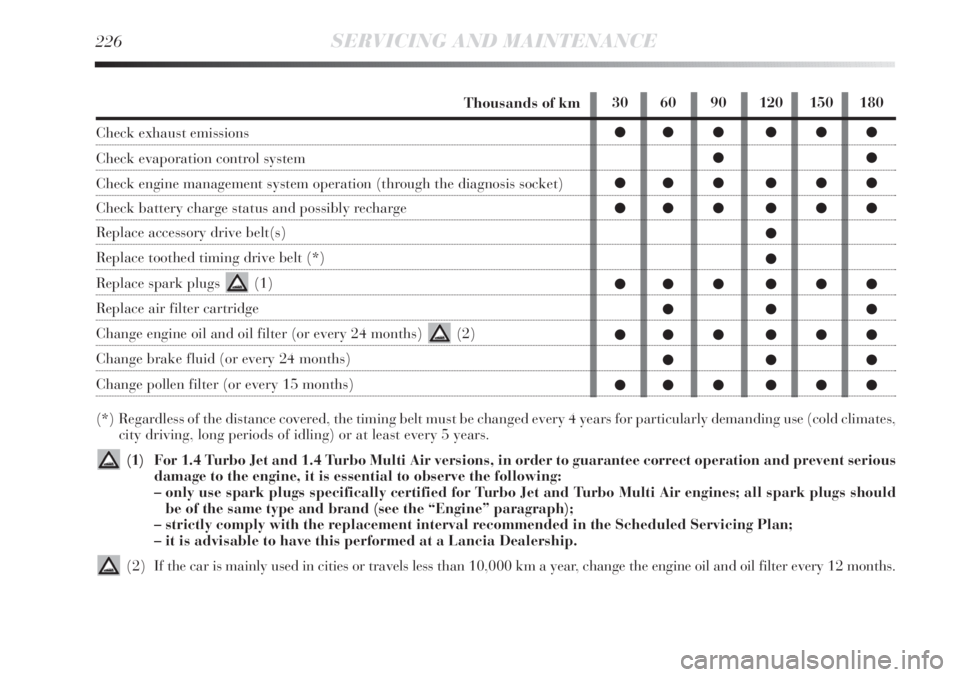
226SERVICING AND MAINTENANCE
Thousands of km
Check exhaust emissions
Check evaporation control system
Check engine management system operation (through the diagnosis socket)
Check battery charge status and possibly recharge
Replace accessory drive belt(s)
Replace toothed timing drive belt (*)
Replace spark plugs (1)
Replace air filter cartridge
Change engine oil and oil filter (or every 24 months) (2)
Change brake fluid (or every 24 months)
Change pollen filter (or every 15 months)
(*) Regardless of the distance covered, the timing belt must be changed every 4 years for particularly demanding use (cold climates,
city driving, long periods of idling) or at least every 5 years.
(1) For 1.4 Turbo Jet and 1.4 Turbo Multi Air versions, in order to guarantee correct operation and prevent serious
damage to the engine, it is essential to observe the following:
– only use spark plugs specifically certified for Turbo Jet and Turbo Multi Air engines; all spark plugs should
be of the same type and brand (see the “Engine” paragraph);
– strictly comply with the replacement interval recommended in the Scheduled Servicing Plan;
– it is advisable to have this performed at a Lancia Dealership.
(2) If the car is mainly used in cities or travels less than 10,000 km a year, change the engine oil and oil filter every 12 months.
30 60 90 120 150 180
●●● ●●●
●●
●●● ●●●
●●● ●●●
●
●
●●● ●●●
●●●
●●● ●●●
●●●
●●● ●●●
Page 228 of 290
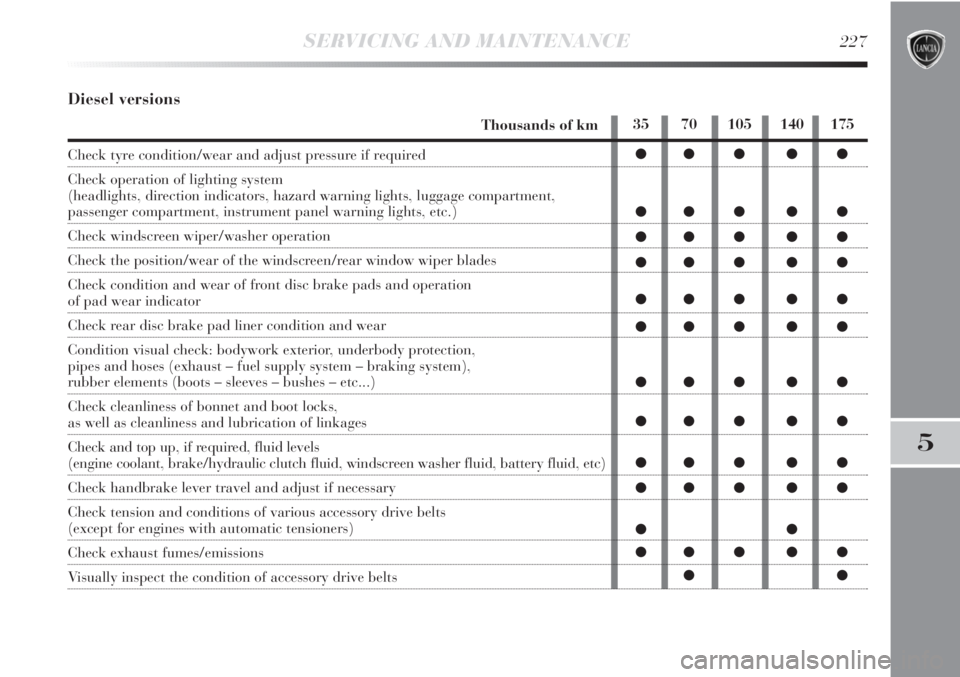
SERVICING AND MAINTENANCE227
5
35 70 105 140 175
●● ● ● ●
●● ● ● ●
●● ● ● ●
●● ● ● ●
●● ● ● ●
●● ● ● ●
●● ● ● ●
●● ● ● ●
●● ● ● ●
●● ● ● ●
●●
●● ● ● ●
●●
Diesel versions
Thousands of km
Check tyre condition/wear and adjust pressure if required
Check operation of lighting system
(headlights, direction indicators, hazard warning lights, luggage compartment,
passenger compartment, instrument panel warning lights, etc.)
Check windscreen wiper/washer operation
Check the position/wear of the windscreen/rear window wiper blades
Check condition and wear of front disc brake pads and operation
of pad wear indicator
Check rear disc brake pad liner condition and wear
Condition visual check: bodywork exterior, underbody protection,
pipes and hoses (exhaust – fuel supply system – braking system),
rubber elements (boots – sleeves – bushes – etc...)
Check cleanliness of bonnet and boot locks,
as well as cleanliness and lubrication of linkages
Check and top up, if required, fluid levels
(engine coolant, brake/hydraulic clutch fluid, windscreen washer fluid, battery fluid, etc)
Check handbrake lever travel and adjust if necessary
Check tension and conditions of various accessory drive belts
(except for engines with automatic tensioners)
Check exhaust fumes/emissions
Visually inspect the condition of accessory drive belts
Page 229 of 290

228SERVICING AND MAINTENANCE
Thousands of km
Check engine control system operation (using diagnosis socket)
Check battery charge status and possibly recharge
Replace accessory drive belts
Replace toothed timing drive belt (*)
Replace fuel filter
Replace air filter cartridge
Change engine oil and oil filter (versions without DPF) (or every 24 months)
Change engine oil and oil filter (versions with DPF) (**)
Change brake fluid (or every 24 months)
Change pollen filter (or every 15 months)
(*) Regardless of the distance covered, the timing belt must be changed every 4 years for particularly demanding use (cold cli-
mates, city driving, long periods of idling) or at least every 5 years.
(**) The engine oil and oil filter should be changed when the warning light on the dashboard comes on, or every 24 months.
If the car is mainly used in towns and cities, change the engine oil and filter every 12 months.
35 70 105 140 175
●● ● ● ●
●● ● ● ●
●
●
●●
●●
●● ● ● ●
●●
●● ● ● ●
Page 230 of 290
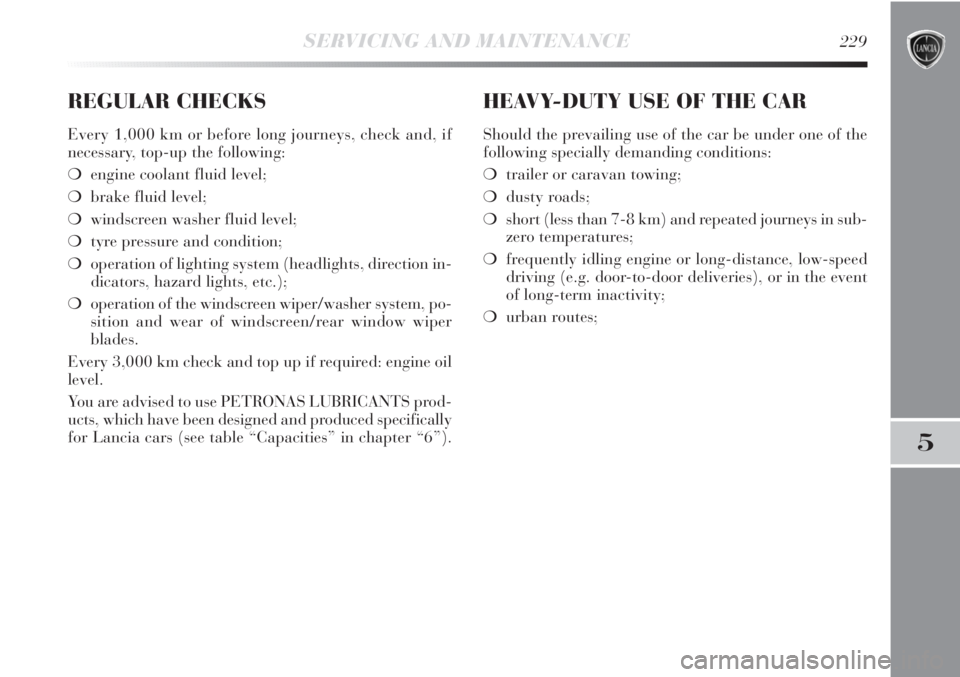
SERVICING AND MAINTENANCE229
5
REGULAR CHECKS
Every 1,000 km or before long journeys, check and, if
necessary, top-up the following:
❍engine coolant fluid level;
❍brake fluid level;
❍windscreen washer fluid level;
❍tyre pressure and condition;
❍operation of lighting system (headlights, direction in-
dicators, hazard lights, etc.);
❍operation of the windscreen wiper/washer system, po-
sition and wear of windscreen/rear window wiper
blades.
Every 3,000 km check and top up if required: engine oil
level.
You are advised to use PETRONAS LUBRICANTS prod-
ucts, which have been designed and produced specifically
for Lancia cars (see table “Capacities” in chapter “6”).
HEAVY-DUTY USE OF THE CAR
Should the prevailing use of the car be under one of the
following specially demanding conditions:
❍trailer or caravan towing;
❍dusty roads;
❍short (less than 7-8 km) and repeated journeys in sub-
zero temperatures;
❍frequently idling engine or long-distance, low-speed
driving (e.g. door-to-door deliveries), or in the event
of long-term inactivity;
❍urban routes;
Page 231 of 290
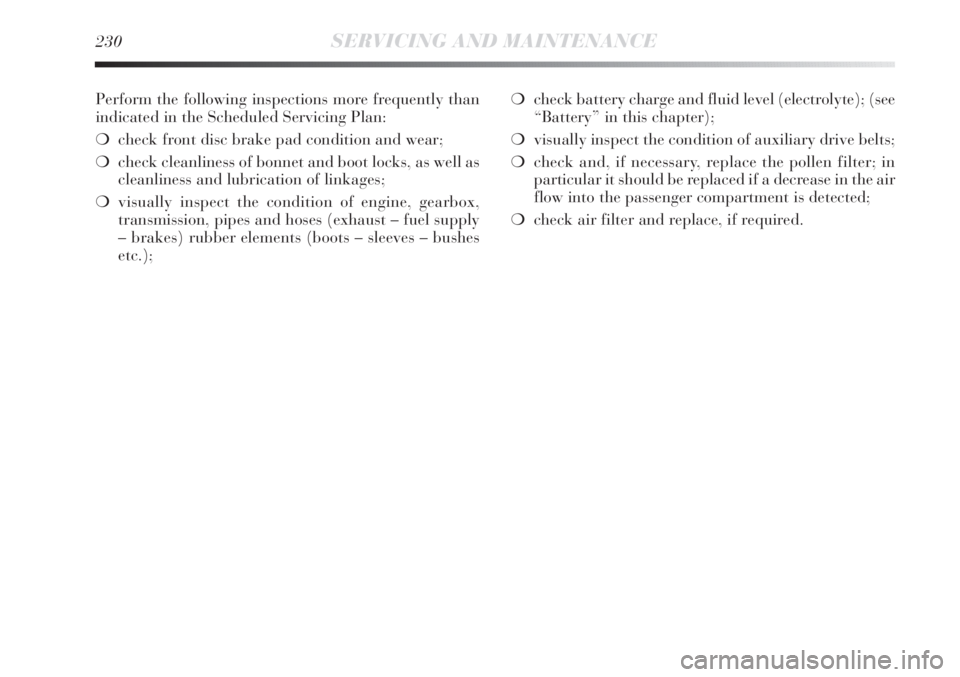
230SERVICING AND MAINTENANCE
Perform the following inspections more frequently than
indicated in the Scheduled Servicing Plan:
❍check front disc brake pad condition and wear;
❍check cleanliness of bonnet and boot locks, as well as
cleanliness and lubrication of linkages;
❍visually inspect the condition of engine, gearbox,
transmission, pipes and hoses (exhaust – fuel supply
– brakes) rubber elements (boots – sleeves – bushes
etc.);❍check battery charge and fluid level (electrolyte); (see
“Battery” in this chapter);
❍visually inspect the condition of auxiliary drive belts;
❍check and, if necessary, replace the pollen filter; in
particular it should be replaced if a decrease in the air
flow into the passenger compartment is detected;
❍check air filter and replace, if required.